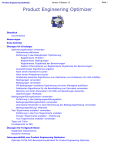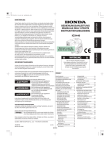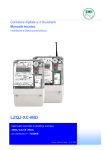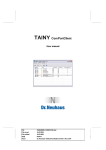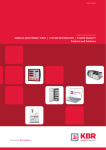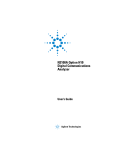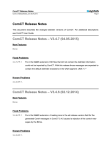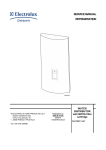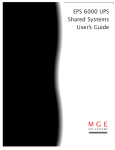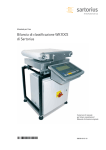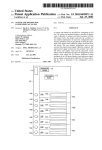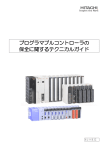Download Operation Manual EMH-COM
Transcript
Operation Manual EMH-COM Communication program for EMH-Electricity Meters Edition: 03.03.2005 EMH-COM-PHB-E-2.00 All of the contents published in this operation manual are copyright. Translating, reprinting, duplicating and also saving of this manual in data processors requires the exclusive permission from EMH. All of the trademarks named in this manual are the property of EMH or the respective title holder. EMH is certified accord. to DIN ISO 9001:2000 and continually endeavours to improve the products. The contents of this operation manual and the technical specifications can be extended, altered or deleted without prior notice. The description of the product specifications in this manual do not represent part of a contract. © 2004-2005 EMH Elektrizitätszähler GmbH & Co KG. All Rights reserved. If you have any questions or inspirations you can contact us at: EMH Elektrizitätszähler GmbH & Co KG Südring 5 D - 19243 Wittenburg Tel.: +49(0)3 88 52 – 645-0 Fax.: +49(0)3 88 52 – 645-29 E-mail: [email protected] Internet: www.emh-meter.de 2 Table of Contents Chapter 1: Prologue ........................................................... 5 Overview of the program modules ..........................................................5 Explanation of how to use this manual ....................................................6 Chapter 2: Installation and release ................................... 7 Hardware-Requirements ........................................................................7 Program installation...............................................................................7 Release ..............................................................................................12 Request Key Code .........................................................................13 Receiving the key code ..................................................................16 Communication requirements ...............................................................17 Installation and settings of the optical communication adapter (OKK).17 Setting up of the local modem ........................................................17 Chapter 3: Program description....................................... 18 Menu- and symbol bar .........................................................................18 Program Description ............................................................................19 Menu File......................................................................................19 Menu option Transfer................................................................19 Menu option Exit ......................................................................19 Menu Direct ..................................................................................20 Menu option Set clock...............................................................20 Menu option Cumulate ..............................................................20 Menu option Identity numbers... ................................................21 Menu option Baud rate..............................................................21 Menu option RCR Relay cumulation position................................22 Menu option Test mode... .........................................................22 Menu option Manipulation... DMZ reset, ITZ reset V2.00 / V3.00, ITZ reset V9.00 ........................................................................22 Menu option Single commands... Read command / Write command ................................................................................23 Menu Read out..............................................................................24 Menu option Table 1 / Table 2 / Table 3 / Service table ...............24 Menu option Load profile ..........................................................25 Menu option Log book... ...........................................................26 Menu option Verification log book ..............................................27 Menu option User log book........................................................27 Menu option Installation check ..................................................27 Menu option eHZ automatic readout...........................................28 Menu option Comment..............................................................28 Menu option Convert ................................................................28 Menu option Graphic display......................................................29 Menu option Open... .................................................................32 Menu option Save.....................................................................32 Menu option Print... ..................................................................32 Menu option Control centre .......................................................32 Menu Setting.................................................................................33 Table of contents 3 Menu option Program settings... ................................................33 Register General..................................................................33 Register Modem ..................................................................35 Register Representation .......................................................37 Field Installation check...................................................................38 Register Export format .........................................................39 Menu Modem ................................................................................40 Menu Configuration .......................................................................40 Menu option Tariff settings ITZ... ...............................................40 Menu option Tariff settings DMZ... .............................................40 Menu option Tariff settings DHZ.................................................40 Menu option Transformer settings DHZ... ...................................40 Menu Info .....................................................................................41 Menu option Program info .........................................................41 Menu option Enter new product key... ........................................42 Menu option Release product key...............................................42 Questions and answers ........................................................................43 Load profile data .................................................................................44 Load profile import in Excel ..................................................................46 Index ............................................................................... 50 4 Table of contents Chapter 1: Prologue The EMH-COM software is a modular software, mit folgenden Kommunikationsund Konfigurationsmöglichkeiten: Kommunikation LZ.. PZ../PE.. DMTZ ITZ DMZ DHZ eHZ D D D D D D D D D D Tarifkonfiguration D Transformer settings In the following, all available program modules are described. It is possible that your program version does not include some of the described program modules which are included here. Overview of the program modules Basic program EMH-COM (Page 17 onwards) Modem (Page 40 onwards) EMH-COM Write commands (page 20 onwards) - cumulate - transfer files - set baud rate - set identity number - delete manipulation Single commands (page 7) - write command - read command Set clock (page 20) Table 3 read (page 24) LP/Graphic (page 29 onwards) - load profile/read log book - graphic LP-display Installation check (page 27) Tariff ITZ (page 40 onwards) Tariff DHZ (page 40 onwards) Tariff DMZ (page 40 onwards) Transformer settings DHZ (page 40) Communication Communication Communication Communication Communication Communication all types VDEW 2.1 VDEW 2.0 DHZ DMZ ITZ Control centre (Page 32 onwards) MSCONS and mail for control centre User – read out LP (page 25) eHZ automatic readout (page 28) Bluetooth OKK (page 33) 90 day-test version Prolouge 5 Explanation of how to use this manual The simple structure of the manual will help you to find the relevant topics quickly. The manual is generally structured as follows: complete path information Explanation of a menu option, e.g of the menu File File M Menu File Transfers files and ends of the program Short description Explanation of a menu option, e.g menu option Transfer... File > Transfer... MO Menu option Transfer... Transfers saved set-, parameter-, tariff-, and ripple control files Short description Explanation of a register, e.g. register General Setting >Program settings ... > General R Short description 6 Prolouge Register General Setting of the COM-interface, passwords and meter address Chapter 2: Installation and release Hardware-Requirements The PC should fulfill at least the following requirements: Processor: Intel Pentium, 100 MHz or higher RAM: at least 32 MB RAM Available hard disc memory: at least 50 MB Operating system Microsoft Windows 98/ME/2000/NT4.0 or XP Accessories: Optical Communication Adapter OKK (with communication via the D0-interface), Local modem for remote configuration with the meter Program installation Procedure: Start the file setup_emhcommas2000kyXXX.exe. The following window appears: Here you select the language version of EMH-COM. Attention: After installation, the language of the basic program cannot be changed. Once the language has been set, click on The following window appears: Click on OK to continue. Next >. Installation and Release 7 The following window appears: We recommend that you accept the proposed program folder. You may however also select a different path. To continue with the installation click on Next >. If the selected program folder does not yet exist, e.g with a new installation, then you will be asked if this folder should be created. To continue click on Yes, in order to go back to the previous window and to set a new path or program folder click on No. 8 Installation and Release In the following window the program description is set which is used in the start menu (Start > Programs...). You can set a new program description or accept the proposal. In order to continue with the installation click on Next >. Note : If the program creates no folder then, in the „start menu“ activate the checkbox! Please consider, that with a deactivation, the program can only start via the Desktop Icon (if present) or directly from the index. Installation and Release 9 In the following window you have the possibility to set if an icon should be inserted on the desktop. With the help of the icon you can start the program directly without having to go via the start menu. In order to insert an icon, activate the checkbox. Click on the installation. Next > to proceed with The Setup now shows you once again all settings which you have made concerning the installation. If you would like to make more changes then you can go back to the previous installation steps by clicking on < Back. Now click on 10 Installation and Release Install. At the end of the installation the following window appears: Click on Finish to end the installation. Note: If, after the installation, you want to start the program activate the checkbox Start EMH—Program. Otherwise the window is closed and the installation is ended. Installation and Release 11 Release Before the program can be executed or used it must be released by means of a product key and a key code. In the following it is described how a program is released. Start the EMH-COM. The following window appears: Please enter the product-key which you received with the CD and then click on OK. Entry of the correct product-key is confirmed with the following announcement. Click on OK. The following announcement then appears. Please read the note and confirm with OK. The entry of the product-key is now ended. In order to request the key code for releasing the program a renewed start of the program is necessary. 12 Installation and Release Start the EMH-COM. The following window appears: The program offers you 2 possibilities to request the key code. You can select if you want to receive the key code by E-mail or Fax. The option Request key code per Mail is a more simple and quicker method to receive the key code. The option Request key code per FAX is usually selected when your computer does not have an internet connection. Request Key Code 1. Possibility: Request key code per E-mail Note: For this option internet connection is necessary. Select the option Now click on Request key code per Mail. Request key code. Installation and Release 13 The following window appears: Please read the announcement and click on OK. A new window from your Standard-E-mail-Program opens automatically. The window already contains all information which is necessary for processing the key code requirements. You only need to send the E-mail. Shortly after this you will receive the key code to release the program. 2. Possibility: Request key code per Fax Select the option Then click on 14 Installation and Release Request key code per FAX. Request key code. The printer menu from your standard printer then opens, e.g.: You can now print out the key code request form on your printer. The fax pre-printed form is as follows: Please enter in the form the fax number where the key code should be faxed to. You also have the possibility to receive the key code per E-mail. For this, enter the E-mail address in the form to where the key code should be sent. Then send the fax to: EMH Elektrizitätszähler GmbH & Co KG Fax-Number: +49-(0)3 88 52-645-29 You will receive the key code shortly. Installation and Release 15 Receiving the key code Once you have received the key code from EMH you can release the program. For this, start the program either via the program icon on the desktop or via the start menu. The window opens which you already know from the key code request. If you received the key code by E-mail then you can copy the key code from the E-mail and insert it into the field. To do this, copy the key code into the clipboard and then place the mouse cursor in the first empty box and use the key combination „Ctrl + V“ to insert the key code. When you have entered the key code (as above) click on OK. If the key code is correct the following announcement appears: If the key is incorrect the following announcement appears: Enter the correct key code once again. The release is now complete. You can start the program via the desktop icon (if it exists) or via the start menu. 16 Installation and Release Communication requirements There are several possibilities to communicate with the meter. In the following, communication via both the optical communication adapter OKK and the electrical interface with a modem is described. Installation and settings of the optical communication adapter (OKK) The optical communication adapter OKK enables communication between a PC and a meter. At the meter, communication to the optical data interface D0 takes place. Connection to the PC takes place, depending on the version and design, via a COM-Port or a USB interface. Procedure: Connect the optical communication adapter OKK to a free COM-Port or a free USB interface on your PC (depending on the design of the OKK). If you have an OKK with USB connection then a special USB driver must be installed. The driver can be found on the CD-ROM which is contained in the scope of delivery with the OKK. Tips for the installation of the driver can also be found on the CD-ROM. Note : Before communication can take place with the meter the interface must be configured under Setting > Program settings ...> Register General(see page 33). Setting up of the local modem In order to communicate with the meter via the modem function some parameters need to be defined for the local modem and the meter modem in advance. For more information about this see page 35. Note: For remote meter readout a standard commercial PC modem is used. On the basis of our many years of experience we recommend an external modem which is addressed with the Standard-Hayes-operations set. The advantage of this modem is its audible loud speaker function and the LED status display. With the set up of a communication line you can observe the connection establishment (visually by means of the LED and acoustically by means of the loud speaker). A modern analog modem is able to call both analog meter modems and GSM meter modems and is also able to read out the meter. On the basis of our long term experience we would like to inform you of the following: Internal modem cards are technically equivalent however, if there are problems, the error search is more difficult. Admittedly ISDN-cards offer the possibility of an analog modem emulation via the so-called virtual COM-Ports however, in practice they often cause many problems. Therefore it is not recommended to use an ISDN-card. Installation and Release 17 Chapter 3: Program description Menu- and symbol bar Note: The program consists of individual program modules (see page 5). If, in the following, menu options and functions are described which do not appear in your program then these program modules have not been released and are therefore not available. If you are interested in further modules please contact us. In the upper part of the program window you can find the menu bar and below this the symbol bar. Via the symbol bar you can quickly access frequently used functions. If you go over the symbol with the mouse a function description appears. Set clock Read out table 1 Read out table 2 Read out table 3 Read out service table Read out load profile Read out log book Comment readout Load profile-conversion Load profile graphic display Save protocol Print protocol Create modem connection Separate modem connection Cancel communication 18 Program description Program Description File M Menu File Transfers files and ends the program File > Transfer ... MO Menu option Transfer... Transfers saved set-, parameter-, tariff- and ripple control files. Procedure: Click on Transfer... Select the file which is to be transferred and click on Open. The file is now transferred to the meter. In order to close the window click on Cancel. Note: Please make sure that in the selection field Files of type the file type is selected which you want to transfer. Otherwise the file to be transferred will not be shown in the window. File > Exit MO Menu option Exit Ends the program Program description 19 Direct M Menu Direct Menu option used to send commands to the meter Direct > Set clock MO Menu option Set clock Sends the PC time and the PC date Here you have the possibility to read out the time and date from the meter or to send the current PC time or PC date to the meter. For this, click on either Read or Write. Note: When you send the PC time and the PC date to the meter the time and the date already set in the meter is then overwritten. Therefore pay careful attention to the correct setting of the PC clock. On the right at the bottom of the computer screen you can find the PC clock. Direct > Cumulate MO Menu option Cumulate Activates a reset in the meter For the existing energy and maximum register new pre-values are formed. The number of pre-values depends on the meter type. Note: Usually the meters have a reset inhibition which is normally equal to the length of a measuring period. That means, that after a reset, within this time no renewed reset can be carried out. 20 Program description Direct > Identity numbers... MO Menu option Identity numbers... Sets and sends identity numbers to the meter Here you can read out the identity number from the meter or send the identity number to the meter. To do this click either on Read or Write. Select the appropriate meter type via the option buttons. Note: Please note that identity numbers with more than 8 digits cannot be represented in the display. Direct > Baud rate... MO Menu option Baud rate... Sets and sends the start- and data baud rate for the external interface. Here you can read out the start- and data baud rate of the meter or send them to the meter. Please make sure that you have selected the appropriate meter in advance via the option buttons. Program description 21 Direct > RCR cumulation position... MO Menu option RCR Relay cumulation position... Reads out and sets the relay contact position of the ripple control receiver. Nach Aktivierung des Menüpunktes öffnet sich folgendes Fenster: Here you have the possibility to read out the relay cumulation of the ripple control receiver. For this click on Read. After the readout, the relevant relay cumulation is marked with an „X“. With a double click in the appropriate field the relay cumulation can be changed. In order to send the changed settings to the meter click on Write. Direct > Test mode... MO Menu option Test mode... Conversion of the pulse-LED Here you can convert the function of the LED pulse and if it is supported by the meter activate a certain tariff. Note: The function test mode is not supported by all meters. Direct > Manipulation... MO Menu option Manipulation... DMZ reset, ITZ reset V2.00 / V3.00, ITZ reset V9.00 Resets the manipultaion register of the DMZ or ITZ meter Note: After activation of one of these menu options the relevant command is sent to the meter immediately. 22 Program description Direct > Single commands... MO Menu option Single commands... Read command / Write command Sends read- or write commands to the meter 1. Example: Read out time from the meter 2. Note: Send identity number to the meter (see also Menu option Identity numbers... on page 21) Program description 23 Readout M Menu Read out The menu Readout contains menu options for reading out the meter and also for processing the data readouts. Readout > Table 1 etc. MO Menu option Table 1 / Table 2 / Table 3 / Service table Read out of the data lists from the meter Table 1: Billing data Table 2: Load profile with pre-adjustment of the load x days (standard: last 40 days) Table 3: EMH-internal data Service table: Service data (momentary values) Note: At the end of every meter read out, a BCC-Check takes place (with special applications CRC). By means of a checksum sent by the meter a check is carried out to see if the meter readout was totally correct (information: BCC = xx OK). With a faulty data read out, at the end of the read out the announcement appears that the sent BCC is not the same as the calculated BCC. The total readout is represented in red. If, in spite of many attempts, it is still not possible to read out the meter correctly then refer to chapter „Questions and answers“ page 43 onwards to find out possible causes. To save the tables click on Readout > Save... Now select the index where you want to save the file. In the field File name enter the name of the file and select the desired file in the field Files of type > Readout files (*.tab). Then click on Save. 24 Program description Readout > Load profile... MO Menu option Load profile ... Read out of the load profile data from the meter. Start date Setting of the start date of the load profile to be read out, start is 24:00 o’clock End date Setting of the end date of the load profile to be read out, end is 24:00 o’clock User – read out LP Read out of the user – read out LP P.02 Note: This function can only be used if the meter has a user - read out LP. Read out compressed Read out of the compressed load profile Note: This function can only be used if the meter supports the reading out of compressed load profiles. Read out complete Read out of the complete load profile Read out identity number additionally In addition to the load profile the selected meter address or identity number from the selection list is read out in order to be able to allocate the load profile to a meter at a later date Note: With the activation of the checkbox Read out complete, the readout of the load profiles can take a long time depending on the size and number of channels. Program description 25 Button Read out of single load profile channels, selection leads to extension of the window. First of all read out all available channels via the button read out available channels. Then you can select the load profile channels to be read out by clicking on the checkbox. To read out the marked load profile channels click on OK. Readout > Log book... MO Menu option Log book... Read out of the operation log book from the meter 26 Program description Start date Setting of the start date of the log book which is to be read out, start is 24:00 o’clock End date Setting of the end date of the log book which is to be read out, end is 24:00 o’clock Read out complete Read out of the complete log book Read out identity number in additionally In addition to the log book entries, the selected meter addresses and identity numbers in the selection list are read out in order to be able to allcoate the log book entries to the meter at a later date. Readout > Verification log book MO Menu option Verification log book Read out of the certification relevant log book P.99 (if configured ) In the verification relevant log book changes of the LED-pulse constants and also of the pulse values from the P-and Q-output are saved. Altogether a maximum of 46 entries are contained in the certification relevant log book. Readout > User log book MO Menu option User log book Read out of the user log book P.200 (if configured) The user log book can be configured customer specific. As a rule the log book contains events such as voltage failures and manipulation attempts with a time stamp. Up to 204 events can be saved. Readout > Installation check MO Menu option Installation check Optional program module For a detailed description see operation user manual EMH-COMBI-MASTER 2000. Program description 27 Readout > eHZ automatic readout MO Menu option eHZ automatic readout Automatic readout of electronic domestic meters eHZ Note: If EMH-COM does not receive a data telegram within 14 seconds, the EMH mobile cuts off the data readout (Timeout). Readout > Comment MO Menu option Comment Comments line by line the read out tables, load profiles and log books. Example: Table 1 without comments: with comments: Note: The table, load profiles and log books are always read out without comments. A comment is also only possible after the readout. Readout > Convert MO Menu option Convert Conversion of load profile data as preparation for data export Example: Load profile data after conversion Note: An explanation of the load profile conversion can be found in the chapter Fehler! Verweisquelle konnte nicht gefunden werden., page Fehler! Textmarke nicht definiert.. 28 Program description Attention: After a conversion for a data export, a graphic load profile display is no longer possible! Export of the load profile data To export the load profile click on Readout > Save ... Select the index in which the file should be saved and enter the name of the file in the field File name. As the file type select load profile export (*.txt) and click on Save. Afterwards you can import the file in a table calculation program e.g. MS Excel, (for more information see page Fehler! Textmarke nicht definiert.). Readout > Graphic display MO Menu option Graphic display Graphic display of load profile data Note: The x-axis (abscisse) describes the time, the y-axis (ordinate) the performance. For every channel a separate scaling of the y-axis can be represented. This must be pre-defined Readout > Graphic display > Channel > Selection. With the horizontal scrolling beam you can move the time axis. With the sliding controller Zoom which can be found in the lower area of the window it is possible to make the view field of the load profile curve larger or smaller. If several days are shown in the graphic then you can change over to a daily display via a double click on one of the shown dates. The cursor always marks a measuring period duration and the measuring period duration can be moved with the cursor buttons Å Æ Ç È and also Pic Ç, Pic È, Pos 1 and End. When you move the cursor in the main area of the window then, in the field below this, the relevant load profile values appear with information about the time stamp and the status entries. Program description 29 Menu bar of the graphic display Graphic > Print... Prints the content of the window Graphic > Exit Closes the graphic display, return to the main window Channel After activation of the menu option window appears. channel the following Via the buttons you can activate all channels or deactivate all channels. Via the checkboxes you can however also activate or deactivate individual channels. In the load profile graphic individual calculations of each channel In the graphic load profile display the scaling of the y-axis is separately shown for every channel. Set zero point of the Y-axis automatically In the graphical load profile display the bottom limit of the yaxis is modified to reach a higher resolution. Scaling only in the visible area Representation of the load profile is scaled to the window size depending on the zoom setting. Transformer factor Multiplication of the load profile data with a transformer factor. Here via the Dropdown-box you can set a transformer factor for the load profile display. This setting has an effect on the scaling of the Y-axis in the display. Provided that you use the control centre of the program you can search for the transformer factor which belongs to a meter/customer. For this click on search for the transformer factor in the control centre data. 30 Program description In the control centre data the identity number is then searched for in order to determine the transformer factor. If no identity number is found in the control centre data the following window appears. The transformer factor then has to be set manually in the dropdown-box. Note: The transformer factor only has an effect on the graphic load profile display and on the print. The load profile conversion is not affected by this. Here a factor for export can be specified independent of the graphic display. Total evaluation complete LP Here it is possible to display and print the evaluation of the total load profile channel by channel. Total evaluation displayed area Here channel by channel evaluation of the load profile takes place of the displayed area in the window. Here the functions Display and Print are also available here. Program description 31 Readout > Open... MO Menu option Open... Opens files e.g. read out tables, load profiles (also converted), protocol files etc. Readout > Save... MO Menu option Save... Saves files e.g. read out tables, load profiles (also converted), protocol files Readout > Print... MO Menu option Print... Prints the content of the window (data readout) Readout > Control centre MO Menu option Control centre Optional program module For a detailed description see operation user manual EMH-COMBI-MASTER 2000. 32 Program description Setting M Menu Setting Setting possibilities for interfaces, modems, passwords, program representation etc. Setting > Program settings... MO Menu option Program settings... Setting possibilities for interfaces, modems, passwords, program representation etc. Setting > Program settings... > General R Register General Setting of the COM-interface, passwords and meter-address Port Setting of the COM-Port when using an optical communication adapter OKK Note: In order to determine the COM-Port when using an OKK with USB connection look under Start > Settings > System control > System-[Hardware]-device manager. Further information about this can be found on the CD-ROM which is included in delivery with the OKK. Baud rate Setting of the interface speed Note: When using an OKK you should always use Mode C . Program description 33 Bluetooth OKK Activate this checkbox when a Bluetooth-OKK is used. Login-password Input of the login-password With activation of this menu option, when logging in, a password is sent to the meter. The password is saved in code with the program settings. W5-password Input of the W5-password Certain set commands (e.g setting of the clock time, writing of the identity number) are only sent to the meter with information about the W5 password. The pre-setting 00000000 must only be changed if a different password was agreed on. Meter-address Input of the meter-address Note: This information is only important if the meter has a meter-address. The meter-address only applies to the meters electrical interface and therefore only comes into question with a remote readout or a special solution. The meter-address can be discovered by reading out the service table. The OBIS-code for the meter-address is 0.0.0. Note: If you have any problems with connection then please read the chapter „Questions and answers“ page 43 onwards. 34 Program description Setting > Program settings... > Modem R Register Modem Setting of the local modem and the meter modem. Telephone number Entry of the telephone number of the meter modem to be called Note: If dialing a number for an outside line is necessary then (often with telephone sets), this number must be at the front of the telephone number. Then enter a „w“. The „w“ causes a short dialing break after reaching the network before dialing further. If the „w“ does not operate property then please contact the telephone administrator and ask for the interval signal. Local modem initialization Selecting the local modem to be used Note: The modems which are most frequently used are listed. If your modem is not included in the list then select the setting allg. Hayes-Modem;AT&FE0X3. This setting functions with most types of modems. Program description 35 Field meter modem selection Selection of the meter modem to be dialed. EMH-COM supports meter modems from the manufacturer Dr. Neuhaus (ZDUE), Görlitz (ENC 280), Elster (DM 100) and Sparkline Modem. Note: As a rule, for simple transparent modems it is sufficient if you activate Auto-Transparent modem. In the field Modem-Timeout as a standard 90 sec are entered. This information causes the program to be automatically interrupted if a „faultless“ connection does not occur. It is not recommended to select a smaller value. With meter modems which have a password protection in the field Modem password the password can be entered. If there is no password activated in the meter modem then the field stays empty. Path to the INI-files 36 Program description In the path C:\Dokument and settings\All Users\Application Data\EMH as a standard the files modem.ini and telefon.ini are found. The file modem.ini contains the modem types which are listed in the selection field local modem initialization. In the modem.ini further modem types can be extended. This should however only be performed by experienced users. The file telefon.ini contains telephone numbers which are listed in the selection field. In the telefon.ini new telephone numbers can be entered which are then available with every start of the program in the selection box Telephone number. Setting > Program settings... > Representation R Register Representation Sets the software surface Large tool buttons The buttons in the tool bar are shown enlarged. Flat tool buttons The buttons in the tool bar are no longer shown as a relief structure. Enlarge font for protocol The font of the data read out is larger. Note: This function is especially helpful with monitors with a very high resolution. Program description 37 Field Installation check 38 Program description Display clockwise The voltages are displayed clockwise: U1=0°, U2=240°, U3=120° Display anticlockwise The voltages are displayed anticlockwise: U1=0°, U2=120°, U3=240° (EMH-Standard) Setting > Program settings... > Export format R Register Export format Setting the export formats for the export of load profiles. Here you can define the layout of the text rows for the export of load profiles. The row is composed from the field Data composition in the above shown sequence. With a double click, individual fields are inserted into or removed from the data composition. Example: 01.01.2005 TAB 09:15 TAB Value Channel 1 TAB Value Channel 2 TAB Status Separator is always a TAB-character. Program description 39 Modem M Menu Modem Optional program module For a detailed description see user manual EMH-COMBI-MASTER 2000. Configuration M Menu Configuration Tariff settings for ITZ, DMZ, DHZ and also transformer setting for the DHZ Configuration > Tariff setting ITZ... MO Menu option Tariff settings ITZ... Optional program module For a detailed description see user manual EMH-COMBI-MASTER 2000. Configuration > Tariff setting DMZ... MO Menu option Tariff settings DMZ... Optional program module For a detailed description see user manual EMH-COMBI-MASTER 2000. Configuration > Tariff setting DHZ... MO Menu option Tariff settings DHZ... Optional program module For a detailed description see user manual EMH-COMBI-MASTER 2000. Configuration > Transformer setting DHZ... MO Menu option Transformer settings DHZ... Optional program module For a detailed description see user manual EMH-COMBI-MASTER 2000. 40 Program description Info M Menu Info Program information and release options Info > Program info MO Menu option Program info Program information The menu option Program info contains information about the program and also the areas of application. Here you also receive the path information for the INI- and control centre files and also the save files. The meter types which the program can communicate with are also listed here. If the installed program is a 90 day test version then it is shown here how many days the program will still run for. Program description 41 Info > Enter new product key... MO Menu option Enter new product key... Entering a new product key for releasing further program modules Procedure: The release of new program modules takes place as described in chapter Release, page 12. Info > Release product key... MO Menu option Release product key... Requesting a new key code and releasing further program modules Procedure: The release of new program modules takes place as described in chapter Release, page 12. 42 Program description Questions and answers 1. No communication to the meter takes place. After a few seconds the announcement Timeout in the communication, Login not possible appears. Possible causes : - The optical communication adapter is not attached properly or not connected correctly. - The interface is not set correctly. When using an optical communication adapter OKK please check the information for the COM-Port in the menu Settings. Perhaps you must select another COM-Port. - The baud rate is not selected correctly. When using an optical communication adapter OKK select in the menu Settings-Mode C. With this setting, the PC and the meter set the optimal baud rate themselves. 2. Communication with the meter takes place however, the read out seems to be faulty. After ending the communication the error announcement appears that the BCC check was incorrect. Possible causes : - With laptops the energy saving function can be activated which switches off the hard disc after a certain period of time. If a hard disc access then takes place (e.g. for the saving of storage area elsewhere), it is not possible to access the hard disc immediately. Delays in the program operation then occur and this can cause reading errors. In this case deactivate the energy saving function via Start > Settings > Control Panel > Power Options. - Your PC does not have enough RAM (Random Access Memory). If less than 32 MB are installed then often the RAM has to be put on to a hard disc. With some computers, due to delays, reading mistakes are caused. - The Buffer (FIFO) of the serial interface has not been set correctly. With transmission problems try out different settings. Unfortunately a general setting tip cannot be given. - When using a laptop and a passive optical communication adapter OKK then, due to a reduced voltage supply, the voltage at the serial interface is no longer enough for a faultless data transmission. In this case we recommend using an optical communication adapter OKK with an USB connection. Program description 43 Load profile data The meter sends for example the following load profile data: /EMH4\@01LZQJC0014F _P0_()_` P.01(10304280000;10304290000) _P.01(1030428001500)(00000000)(15)(2)(1.5)(kW)(3.5)(kvar) (1.484)(0.600) (1.480)(0.600) ... This format can be converted by EMH-COMBI-MASTER 2000 so that the data can be saved as a changed text file and then imported into a table calculation e.g. MS Excel. When table 2 from the meter (pre-configured with load profiles) or the load profile is read out via the menu option Readout > Load Profile..., the meter sends all measured load profile channels. Depending on the type or configuration of the meter the load profile channels can be defined differently. The load profile contains information about which OBIS value (OBIS=ObjectIdentification-System) stands for the individual channels. Explanation of the rows: P.01(1030428001500)(00000000)(15)(2)(1.5)(kW)(3.5)(kvar): (1.5) (kW) (3.5) (kvar) OBIS code of the first channel (W+) Unit of the first channel OBIS code of the second channel (WQ+) Unit of the second channel Explanation of the rows (1.484)(0.600): (1.484) 1,484 kW (0.600) 0,600 kvar After conversion, the load profile file (without separators) is as follows1: Date 28.04.04 28.04.04 Start 00:00 00:15 End 00:15 00:30 1.5 1,484 1,48 3.5kvar Su/Wi 0,6 S 0,6 S Status 0000 0000 0000 0000 Every row is equal to a measuring period (usually 15 minutes) and contains information about the start- and end time. If the meter supports information about the season identifier then S for summer time or W for winter time is entered. The status column contains information about certain events which the meter saves (for the construction see VDEW requirement specifications). These events are mainly voltage failure/return, setting the clock, season change (winter/summer time), cumulation etc. If nothing occurs then 0000 0000 is the output. 1 The layout of the text rows can be changed via 44 Program description Setting > Program settings... > Export format. Events can occur within a measuring period individually or with other events together. The following tables show a few examples: One event per measuring period Meaning Measured value interrupted Season change Reset Clock set Voltage return Voltage failure Entry in the load profile 0000 0000 0000 0000 0000 0000 0004 0008 0010 0020 0040 0080 Two events per measuring period Meaning Clock set + Measured value interrupted Clock set + Season change Clock set + Reset Voltage recovery + Reset Power failure + Voltage recovery Entry in the load profile 0000 0024 0000 0028 0000 0030 0000 0050 0000 00C0 Three events per measuring period Meaning Clock set + Reset + Season change Entry in the load profile 0000 0038 Program description 45 Load profile import in Excel The exported load profile file (here named opened: Musterlastprofil) looks as follows when In order to import the file Musterlastprofil in Excel and to represent the load profile graphically proceed as follows: 1. Open Excel. 2. Click on Datei > Öffnen. 3. Select the file type seen. 4. Open the file 46 Program description Dateityp (*.prn; *.txt; *.csv). Musterlastprofil. The file Musterlastprofil can now be 5. In the following window click on Ende. 6. Mark the desired display area, e.g. 1 day over the columns A to E. Program description 47 7. Now call up the Diagram-Assistant and select the 8. Click on the button Weiter > Standardtypen Linie. until the following window appears In the box Diagrammtitel enter for example Load profile, in the box Rubrikenachse (X) enter Time and in the box Größenachse (Y) enter W+, WQ+. Then click on the box Weiter >. 48 Program description 9. In the following window you must decide if the diagram should be included on the active page or if a new page should be created for the diagram. Then click on the button Ende. 10. In this example we have decided to create a new page. Excel has created a new page for the title Diagramm, on which the load profile is graphically represented. Program description 49 Index B M baud rate ......................................................5, 21, 43 Bluetooth OKK .................................................... 5, 34 momentary values................................................... 24 MSCONS................................................................... 5 C O comment................................................................ 28 COM-Port ....................................................17, 33, 43 control centre .......................................... 5, 30, 31, 41 control centre file ................................................ 41 conversion............................................. 28, 29, 31, 44 OBIS ...................................................................... 44 optical communication adapter OKK3, 5, 7, 17, 33, 34, 43 D pre-values .............................................................. 20 product-key ............................................................ 12 D0 ......................................................................... 17 data export........................................................28, 29 load profile export ............................................... 29 data read out............................................... 24, 28, 32 data readout readout ........................ 5, 17, 18, 22, 24, 25, 28, 34 date set date .............................................................. 20 E eHZ readout ....................................................... 5, 28 G graphic display............................................. 18, 29, 30 graphic load profile display ...........................29, 30, 31 I interfaces ............................................................... 33 COM-Port.................................................17, 33, 43 optical interface .................................................. 17 serial interface .................................................... 43 USB interface ........................................... 17, 33, 43 K key code ................................ 3, 12, 13, 14, 15, 16, 42 L load profile5, 18, 25, 26, 28, 29, 30, 31, 32, 39, 44, 45, 46, 49 compressed load profile ....................................... 25 load profile data ........................... 25, 28, 29, 30, 44 load profile export................................................... 29 log book .......................................5, 18, 25, 26, 27, 28 operation log book ....................5, 18, 25, 26, 27, 28 User log book...................................................... 27 login-password ....................................................... 34 50 Index P R read command.......................................................... 5 readout ............................ 5, 17, 18, 22, 24, 25, 28, 34 readout lists service table ................................................. 18, 34 table 1................................................................ 18 table 2.......................................................... 18, 44 table 3................................................................ 18 release .......................................... 3, 7, 14, 16, 41, 42 reset .............................................................3, 20, 22 reset inhibition ........................................................ 20 ripple control file ................................................. 6, 19 S season ................................................................... 44 serial interface ........................................................ 43 service table ..................................................... 18, 34 set date.................................................................. 20 set time.................................................................. 20 T table 1.................................................................... 18 table 2.............................................................. 18, 44 table 3.................................................................... 18 test mode ............................................................... 22 time set time .............................................................. 20 transformer setting ................................................. 40 U USB interface...............................................17, 33, 43 user log book.......................................................... 27 W W5-password.......................................................... 34 write command ................................................... 5, 23



















































